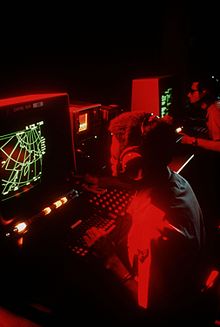Eareckson Air Station
With the successful completion of the Aleutian Campaign in August 1943, Eleventh Air Force came within striking distance of the Japanese Kurile Islands, the northernmost being 750 miles to the south-southwest of Shemya.Six B-24 Liberator bombers from the 21st Bombardment Squadron on Shemya were scheduled to join them, but they were diverted to attack Japanese transport ships spotted by a Navy PBY aircrew.Using time/distance calculations they dropped their 500-pound bombs though the clouds on what they believed were the Japanese installations, then headed back to Alexi Point and landed after nine and a half-hour, 1,000-mile flight.The Japanese defenses were taken by surprise, with only five Mitsubishi A6M "Zero" and a few Nakajima A6M2-N "Rufe" float plane interceptors sent up which were unable to catch the retreating B-24s.[2] At the time, the Soviets were officially, for strategic reasons, neutral in the war between the Japanese Empire and Western Allies; in order to maintain this neutrality, international law required Soviet authorities to intern any Western Allied personnel forced to seek refuge in the USSR as a result of operations against Japan.In reality, however, US aviators who made forced landings on Kamchatka were secretly returned to the United States, by way of a camp in the Kazakh SSR and Iran (which was under British and Soviet occupation at the time).Over the next few years, dozens of US aircraft with mechanical problems and/or damage from by Japanese defenses were diverted to Soviet bases on Kamchatka – usually Petropavlovsk-Kamchatsky.Some of the internees complained about their treatment in the USSR – including accommodation which, to the Americans, resembled prisoner of war camps,[citation needed] and their interrogation by Soviet officials.[citation needed] The aerial photos taken on the raid of 11 August 1943 showed that the Japanese were building up forces in the area, transferring aircraft presumably from air bases on Hokkaido.The mission would be to carry out both day and night bombing and photo-reconnaissance attacks on the Kuriles, and also to conduct searches for Japanese shipping, including fishing vessels in the North Pacific.In early April, the 2d Photographic Charting Squadron arrived with four F-7 Liberators, from Peterson Field, Colorado, configured for photo-reconnaissance and mapping.[2] Additional aircraft and personnel reductions occurred in 1945 and almost all air bases other than Alexi Point, Shemya and Davis in the Aleutians were reduced to caretaker status.The 77th Bomb Squadron flew a B-25 mission over the Minami Cape Radar Station and lost two aircraft; both crews captured by the Japanese.[2] In August, after the Soviet Union declared war against the Japanese Empire, B-24s were dispatched on reconnaissance and intelligence-gathering missions to observe the Russian activity in the Kuriles.Photographic missions were flown beginning on 4 August and continued until 4 September when the B-24s encountered some Russian fighters and turned back without incident.Abandoned vehicles, warehouse stores of all types, rations, clothing and all the other tools of war, including ammunition and bombs were simply left out to the elements.For a time the Air Force considered transferring the island to the Civil Aeronautics Authority, the forerunner of the Federal Aviation Administration.However, the Air Force decided to retain Shemya because its location provided an ideal refueling stop on the Great Circle Route from Japan to McChord Field, Washington.The Korean War brought extensive use by the Military Air Transport Service (MATS) for the logistical support of Korea and Japan.[4] The Reeve operated Electra propjets and 727 jets were both configured as combi aircraft and were capable of transporting mixed loads of passengers and freight on their respective main decks.Shemya also continued to support the Great Circle Route for MATS and later Military Airlift Command transports between Japan and Elmendorf AFB.It also became a Strategic Air Command refueling site for B-52 Stratofortress bombers and KC-135 tankers as part of Operation Chrome Dome.Shemya also supported various SAC Boeing RC-135 "Rivet" reconnaissance aircraft flying along the Soviet Pacific Coast with on-board sensors which enable the crew to detect, identify and geolocate signals throughout the electromagnetic spectrum.ADC organized the 16th Surveillance Squadron with AN/FPS-17 Detection and AN/FPS-80 Tracking Radars to monitor Soviet missile tests on the Kamchatka Peninsula and to support the Air Force Spacetrack System.







Shemya IslandAlaskaUnited StatesCobra DaneL-bandphased-arrayDepartment of DefenseUS Air ForceUS Space ForcePacific Air Forces Regional Support CenterSpace Delta 4AN/FPS-108 Cobra DaneNear Islands earthquake (1975)RaytheonAsphaltFederal Aviation AdministrationUnited States Air ForceShemyaAlaskanAleutian IslandsElmendorf AFBdiversion airportAN/FPS-17AN/FPS-80Anchorage1965 Rat Islands earthquake1975 Near Islands earthquakerunwayWilliam O. Earecksonskip bombingForward Air Control (FAC)B-29 SuperfortressB-24 Liberator344th Fighter SquadronP-40 WarhawksP-38 LightningsUC-64ATB-26sConsolidated PB4Y-2 PrivateersC-47 "Gooney Bird"Aleutian CampaignEleventh Air ForceKurile IslandsParamushiroKataokaDoolittle RaidIX Bomber CommandB-25 Mitchells77th Bombardment SquadronAdak AAFAlexai Point AAF21st Bombardment SquadronMitsubishi A6MNakajima A6M2-N404th Bombardment SquadronSovietPetropavlovskKamchatka PeninsulainternKazakh SSRprisoner of war campsHokkaidoParamushirShumshuAleutian Islands Campaign28th Bombardment Group77th Fighter SquadronNaval Air Station AttuDavis AAF2d Photographic Charting SquadronF-7 LiberatorsPeterson Fieldfire balloons66th Fighter SquadronMcChord FieldKorean WarMilitary Air Transport ServiceOrientNorthwest Orient AirlinesCanadian Pacific AirlinesReeve Aleutian AirwaysLockheed L-188 ElectraBoeing 727-100combi aircraftMilitary Airlift CommandWB-50D SuperfortressesAir Weather ServiceB-52 StratofortressKC-135Operation Chrome DomeBoeing RC-135Air Defense Command9th Air Division16th Surveillance SquadronAN/FPS-108SALT IICobra Balltheater ballistic missileanti-ballistic missileAerospace Defense CommandStrategic Air CommandAir Force Space CommandPacific Air Forces11th Air Control WingChina Eastern Airlines Flight 583Alaskan Air CommandAir (later Aerospace) Defense Command11th Fighter Squadron54th Fighter Squadron343d Fighter GroupRoyal Canadian Air ForceNorth StarDouglas DC-6AAlaska Airlines Flight 779Boeing RC-135Swent down in the Bering SeaLockheed C-5A GalaxyCathay PacificBoeing 777-300ERDelta Air LinesPolar Air CargoPetropavlovsk-KamchatskyCensus-designated placeUnorganized BoroughAleutians West Census AreaState senator